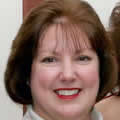Kathy Layne

B.S. Mathematics 1976, M.S. Statistics 1993
Engineering Group Manager, Allison Transmission
Written by: Shannon Knapp, Ph.D. candidate in Statistics
Kathy Layne did not set out to become a statistician. A native of Indiana, Layne attended Purdue, following her then boyfriend and now husband, Jerry Layne. She liked math and knew that Purdue had an excellent reputation for the sciences. She was not interested in becoming a teacher, so she studied applied math. In retrospect, Layne thinks actuarial science would have been a perfect fit, but she wasn’t familiar with the field at the time. For fun, Layne took radio and TV classes, which lead to an internship at Channel 18 in West Lafayette and then a part-time job as a weathercaster for WISH TV in Indianapolis from 1977 to 1978. Her full-time employment was working as an engineering analyst for FMC Bearing Division, in Indianapolis, performing time studies and value analysis projects. As part of a team at FMC, Layne earned a patent for a Bearing Take-up Apparatus, which improved on an existing design enabling flexible positioning for bearings on a conveyor line.
Since 1980, Layne has worked for Allison Transmission in Indianapolis. Shortly after hiring on, someone handed her a SAS manual and some data and told her to get started. She soon found herself doing a lot of statistical work on the job. After working at Allison for several years, Layne applied for and was awarded a fellowship from General Motors, which allowed her to return to Purdue. GM not only paid for her tuition, but paid her half her standard salary for the year-and-a-half it took for her to complete a Master’s in Statistics. "I was impressed with how bright the students and the professors were." She found the department "a very welcoming environment. It didn’t seem too overwhelmingly big." Though older than most of her classmates, Layne’s work experience allowed her to better appreciate the relevance and potential applications of her coursework. She enjoyed all her classes, but knew that Design of Experiments would be used most on the job. To this day, Layne keeps notes at her desk from a Sampling and Survey class taught by Professor George McCabe and a Quality Control class taught by Professor David Moore.
Many of her responsibilities at Allison involve coaching teams. As a GoFast coach, Layne was charged with smoothing out any problems that were encountered, making processes faster and more efficient. As the Design for Six Sigma Coach, Layne helps teams avoid problems in the first place. A Design for Six Sigma Master Black Belt, Layne explains, "Design for Six Sigma is different than Six Sigma. Design for Six Sigma is done in the design phase, when you have more latitude. It is based on good fundamental engineering and understanding what your customer wants from your product." The statistical part of Design for Six Sigma uses Design of Experiments techniques, subjecting products to variation in the customer environment, and ensuring the final product is robust to those conditions. Layne wears a dual hat on the Design for Six Sigma team. She is the team statistical analyst and, as coach, she makes sure everyone understands their role on the team and helps them work through the process.
Often coworkers come to Layne with data; ranging from Product and Manufacturing Engineering studies to employee survey feedback, customer satisfaction survey responses, and safety data. Some might have a question such as whether there is a difference in the failure rate of parts from different suppliers. Others just want to know if their data reveals anything and need some data mining. With such a diverse group of people coming to her, Layne emphasizes, "It is imperative to have people skills. I really have to listen to my customer.... listen to what question they are trying to ask and have answered."
While Layne didn’t start out pursing teaching, she ended up being a teacher in her workplace. She spends a great deal of time in the classroom, teaching her co-workers about statistical topics. She teaches classes on using the Weibull distribution to model reliability data, design of experiments, the Design for Six Sigma process, using statistical features of Excel (such as t-tests), and graphical techniques (such as box-plots). She even uses the textbook "Introduction to the Practice of Statistics" by her Purdue Statistics Professors David Moore and George McCabe (the same text used for STAT 301 and STAT 501 here at Purdue) along with the video series "Against All Odds" by David Moore.
Layne’s favorite part of her job is the teamwork. "Working with a diverse group of people, there is a powerful synergistic effect. Everyone brings something different to the table.... I also really like working with data and do a lot of programming in SAS."
"There’s an opportunity to use statistics anywhere there is data. I know students have heard this before, but it is important to look for something you enjoy doing." If students have an interest in working with data in an engineering or manufacturing environment, Layne recommends statistics students take a class in an engineering field that interests them and try to get an internship. It shows that the students are trying to get out there and get some experience.... Consulting or STATCOM experience is great." But as a recruiter, Layne does not expect students to know it all before they are hired. "Learning should be a lifetime process. So much of what we do is on the job training."
To read more Alumni Profiles, please visit our Alumni Profiles archive.